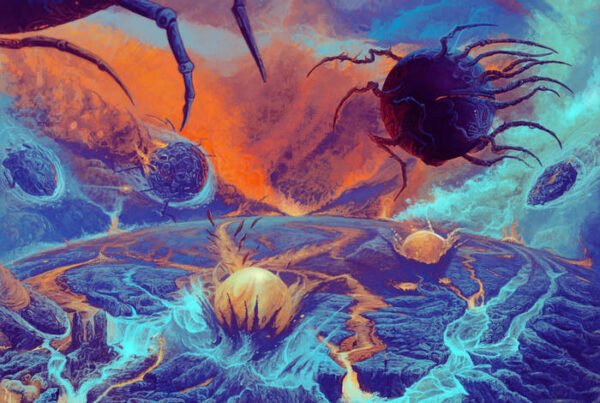Conceived as something of a supergroup (if you could call it that), OSMIUM consists of Oscar winning Icelandic composer and cellist Hildur Guðnadóttir working alongside vocalist Rully Shabara (Senyawa) as well as sound designer Sam Slater and recording engineer James Ginzburg. The project, albeit in early stages of development, has worked on a number of live shows since their debut performance at Unsound in 2022, they have since brought their blend of hypnotic soundscapes and robotic sound design, that channels a primordial characterisation and mythical textures, supporting the likes of Sunn O))) and Fennesz. With the quartet’s debut self-titled album, OSMIUM demonstrates the artists’ innovativeness to explore ancient worlds through custom made acoustic instrumentation experimenting with industrialised sound manipulation and raw folkloric catharsis.
The album at large integrates a lot of experimentation through the use of hand crafted electro-acoustic instrumentation executed in such visceral fashion. The opening track contains intense minimalistic cello-like riffs and tribalistic percussive sections over these low throaty vocal chants, the mood pertains an eerie, tribalistic sense of dread. These folkloric rhythms persist in the next track and the variety of technique in regard to the vocals is exhibited predominantly through a combination of screams, chants, wails, and call and response themes. The sonic utilisation of both voice and machine prevails to their boundless ends, demonstrating the record’s experimental nature and emphasis on pushing these musical elements to their limits.
There is a disturbing feel to the record’s atmosphere upholding a slight feeling of apprehension distinguishable through the low frequency textures that capture the intensity, crafting daunting and unfamiliar surroundings. These atmospheres, which can be noted particularly on the second, fourth, and sixth track intertwines moments of dissonance through the delicately crafted sound design recipes that are borrowed from both the distorted electronic sound manipulation with that of the orchestrated acoustic instruments. You get a transcendent feeling when you are engulfed by these sinister textures, one which transports you into another plain of primordial existence.
What also stands out notably on some of the other tracks like the album’s third and seventh track, is the use of electronic sound design primarily through the industrialised percussion embedded to maintain sonic pressure, and within the soundscapes that contain glitch-like, distorted textures. The impactful use of these densely crafted rhythms and electronically manufactured sound elements are so articulate in their delivery when played against an ancient mythic backdrop. It successfully achieves this pursuit of blurring the lines between past and present. For instance, the fast, visceral drum beats on the final track, maintain this factory-esque quality that signifies an industrialised musicality, this being implemented on top of several layers of intense tribalistic drums adds an element of rawness, transporting the listener to a dystopian, yet ancestral land.
OSMIUM is certainly a project that boasts a wide range of talent from an ensemble that contains a sharp and vast musical vocabulary. For a debut album, that seems to be a greatly promising asset to the world of experimental music, OSMIUM utilises a dexterous range of sonic tools that recognises the strongest aspects of both analogue and digital playbook. Already building on the momentum from their live shows, this record not only will allow OSMIUM the freedom to carve a name for themselves in the spheres of the experimental underground, but by using such music to conjure up a highly cathartic and ancient aesthetic that gives acts like Heilung a run for their money, this project could potentially reach a wider platform with the reputation of the artists themselves and their persevering work ethic.






